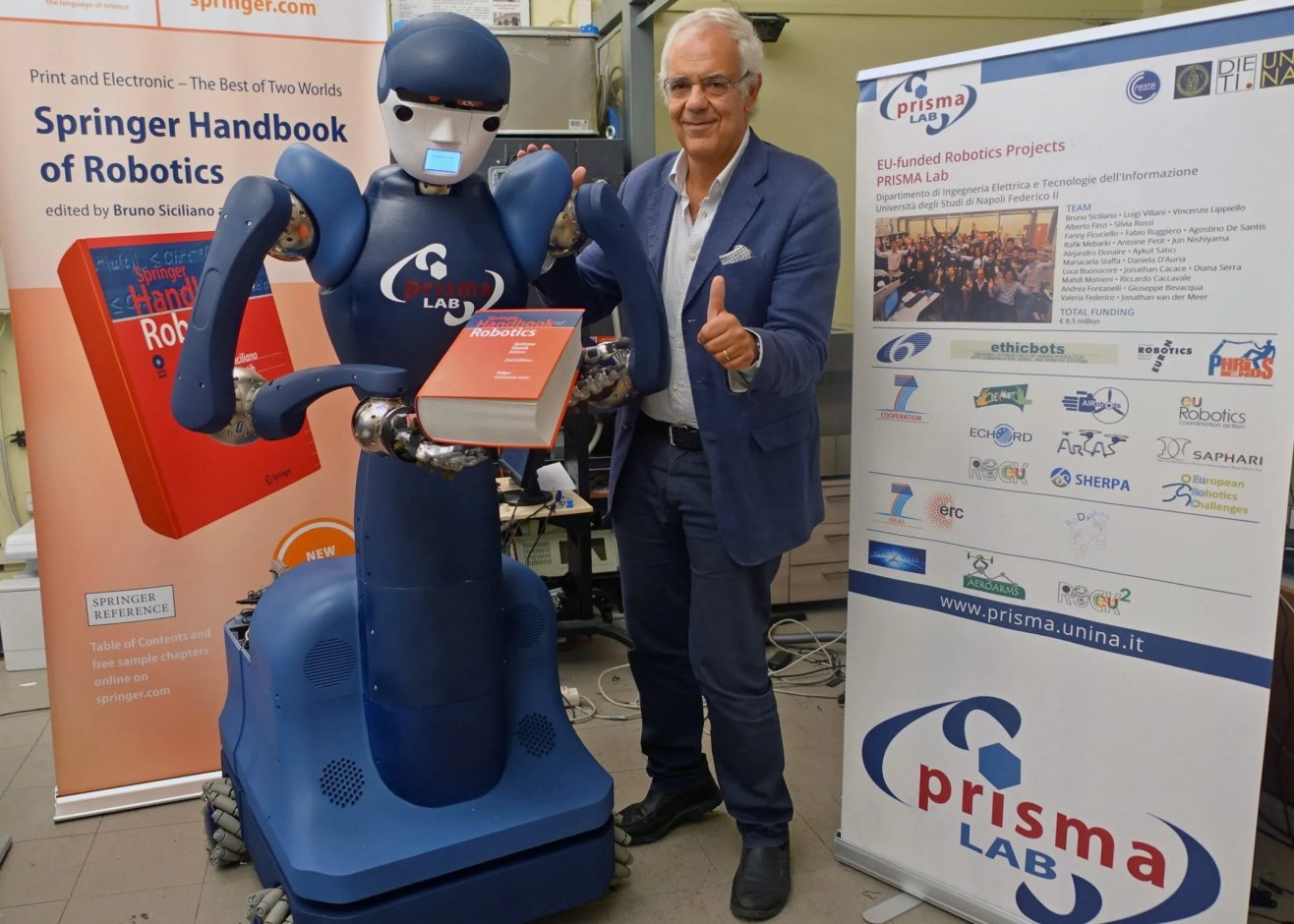
 Enrico Parolisi for F-Mag (a magazine of Fortress Lab)
Enrico Parolisi for F-Mag (a magazine of Fortress Lab)
Italian innovation: From pizza to surgery, robotics is a Neapolitan excellence
- WTI Magazine #148 Feb 19, 2022
-

 Enrico Parolisi for F-Mag (a magazine of Fortress Lab)
Enrico Parolisi for F-Mag (a magazine of Fortress Lab)
We publish this article, in its English translation, courtesy of the publisher Fortress Lab, of the author and of the magazine Fmag, which we thank, where it was published in the Italian version on February 5th.
"Just as I was talking to you I was booking the hotel for Bastia. Professor Oussama Khatib has been developing for 5 years a project of marine archaeology with a humanoid robot underwater archaeologist that will go on a mission at 500 meters depth between Corsica and Elba Island and the French Government has officially invited me on board".
This is Bruno Siciliano, Professor of Automation at the University of Naples Federico II, who together with Khatib in 2008 edited the "Springer Handbook of Robotics", in practice known as the Bible of robotics and which boasts a double recognition from the PROSE Award (The APA-American Publishers Awards for Professional and Scholarly Excellence) with the victory both in the Engineering & Technology sector category and in the general Excellence in Physical Sciences & Mathematics category.
In spite of this, Professor Siciliano speaks of an almost science fiction future, making it sound like something within anyone's reach, a future in which robot divers with archaeological skills capable of descending to a depth of half a kilometer (and more) are something normal to discuss, like a match of the Napoli soccer team.
The pizza-making robot
Even the less accustomed to robotics will be familiar with the name of Professor Siciliano: someone will remember when in PRISMA Lab in Naples, almost as a sacrilege in the city, was born a robot called RoDyMan (acronym for robotic dynamic manipulation) able to ... make pizza. The team led by Siciliano certainly didn't have the objective of replacing the Neapolitan pizza artists, despite the fact that it was helped by a well-known champion such as Enzo Coccia who, for the occasion, wore sensors like those of actors or athletes in films and video games capable of capturing his movements and instructing the machine. With an expedient that certainly has a media appeal, PRISMA Lab has certainly attracted attention but it has also been an example of application of the solid research on which the experimentation on the dynamic non-prehensile manipulation of deformable objects was based.
"We were looking for a demonstrator - explains Professor Siciliano - that would allow us to test the robot's ability and the dexterity required. The intuition came to us while eating a pizza in the lab, working late on the RoDyMan research proposal that would later be funded by the European Research Council, unique on robotics in the 2012 call. What better example than the steps involved in making a pizza?" Rolling out the dough to form a disc, twirling it without breaking it, seasoning it and, above all, baking the pizza in an oven with a shovel by imparting two movements (push and rotation) represented a perfect challenge for the manipulator robot to show its worth. Benchmarks, especially the last one mentioned, not easy to solve. "The research had a much broader scope than the media and had applications in more typical concepts than stage."
From pizza to surgery
One example of application of that research is in medical and surgical settings. Robotic surgery is now part of our lives, but there are still open questions and one of them concerns the manipulation of soft tissues, a subject that concerns surgery in general but also in specific branches such as urological surgery, gynecological surgery and so on. From laying a cake to manipulate this type of tissues the step is (as far as possible) short.
"At the ICAROS Interdepartmental Center for Research in Robotic Surgery," explains Professor Siciliano, who is also its director, "we have a medical robotics lab equipped with a special setup called the daVinci Research Kit. It is an open research platform based on the daVinci robot of the company Intuitive, the most popular system at the clinical level for robotic surgery, and it is an open platform that can be interfaced with a computer to test new algorithms and assemble new tools. We have tested new surgical techniques that make use of sensory information that is not only that of vision but that thanks to the palpation of tissue would return a measure of strength in order to increase the sensory perception by the surgeon. The dream is to have tomorrow an operating console in which the surgeon in ergonomically advantageous conditions will be able to govern all phases of a surgical operation in augmented reality by feeling the tissue as if operating with a laparoscope, a manual instrument. Currently, robotic surgery systems do not include tactile perception, so all the operations the surgeon performs are done by interpreting images."
Incredible to think that the scope of the same research can be applied to surgery but also to the industrial system by providing robots for footwear for example. "We collaborated with a company in Vigevano (Lombardy) that makes robot machines for shoe factories. The starting point was a robot that could visually recognize and touch the uppers for stitching on the shoe. We're not talking about machines for mass production, but luxury machinery for major Italian fashion brands. We basically applied some techniques for pizza manipulation to shoes."
The employment that exists
And this, according to Siciliano, is the beauty of doing research in robotics: having spin-offs in the most disparate fields, without "a specific aim". This in one of the sectors that is now defined as a science in its own right and that cannot disregard the knowledge and contamination of other fields, including concepts that until a few decades ago seemed to be a heritage only of the humanities, apart from Asimov's robotics laws. "I happen to attend - Siciliano says - fewer and fewer engineering congresses and more and more congresses with doctors, with ethics experts... three years ago, for example, I went to the national convention of AIDP, the association of personnel managers. People think that because of robots, jobs are being lost. The real problem is in the turn-over, in the reconversion of the work: the big technological innovations are opportunities to create new jobs".
According to the Forrester Job Forecast report, 12 million jobs will be lost in Europe due to automation. But the headlines, which wink at sensationalism, do not recite the second part of the verse: human evolution itself will lead to the creation of at least 9 million jobs in the Old Continent. And these are not the only data that prove Professor Siciliano right: according to LinkedIn, among the rising jobs in 2022, the first place is for the robotic engineer, which is placed before the machine learning engineer and the cloud architect. The job placement of Automation, after all, is at 99% and students of Professor Siciliano have placed in companies such as Boston Dynamics (have you ever come across videos of robots doing parkour?).
The ecosystem of research in robotics
PRISMA Lab and ICAROS are to be considered absolutely two excellences on a worldwide scale in the field of robotics, and are two realities from southern Italy that demonstrate that even under Rome there is research and innovation of the highest caliber, with all the difficulties involved. In 21 years, the Neapolitan school of robotics has produced 10 full professors, almost all of them in the field of automation. As evidence of the long history of success that has led to funding in European projects and international recognition in various fields of application, there is the recent partnership of the University with RoboIT, the first national center for Technology Transfer of Robotics. In addition to these excellences, there is the experience of the CREATE Consortium, of which the Federico II University is a member, where the efforts on automation and robotics are increasing. Network and synergies put in place allow the cluster to compete with other realities on the Italian territory.
What are the current research challenges in PRISMA Lab? They range from inspection and maintenance of industrial and civil infrastructures (e.g. hybrid drones with omnidirectional wheels able to slide along the pipe with a manipulator arm and a tool to make the thickness of the pipes) to logistics and manufacturing up to medical robotics, but there are also sectors that allow non-experts to fantasize like projects on lunar rovers or quadruped robots for agriculture that autonomously manage a vineyard.
Who will pick up the legacy of the pizza robot? "Our specialty - Siciliano concludes - is the design of innovative control techniques. I'm not saying these are totally independent of the setup, but it's clear that if we develop a new sensory control technique, it is often transportable to a different context. Consider the quadruped robot. In its walking, the quadruped, in contact, presents types that from a mathematical model, dynamic model, and control point of view is similar as an issue to that of non-prehensile manipulation, such as the pizza that was on the shovel in the oven. RoDyMan has been an extraordinary training ground for many young people who have also come from abroad to Naples to do research".